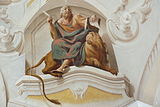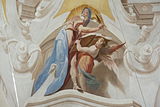St. Georg (Bichl)
The Catholic Kuratiekirche St. Georg in Bichl , a parish in the Upper Bavarian district of Bad Tölz-Wolfratshausen , was built in 1751/52 on the site of various previous churches in the late Baroque style. The builder was Johann Michael Fischer . With its ceiling frescoes and stucco paintings, St. Georg is one of the most beautiful village churches in the Pfaffenwinkel .
history
The Georgskirche has belonged to the Benediktbeuern monastery since it was founded in the 8th century . The church is mentioned for the first time in a deed of donation from 1147. At the end of the 15th century, the church was probably rebuilt or rebuilt in the Gothic style . In 1672 Kaspar Feichtmayr created a new bell tower that has been preserved to this day. Since the old church had become dilapidated, Abbot Leonhard Hohenauer had a new church built in the middle of the 18th century under the direction of Johann Michael Fischer . The old church was torn down except for the tower in 1751, and the new building was completed after two years. The consecration by the Augsburg auxiliary bishop Franz Xaver Adelmann von Adelmannsfelden did not take place until 1758.
A comprehensive interior renovation took place in 2015/16.
architecture
Exterior construction
The entrance facade in the east is structured by two double pilasters and the blown triangular gable above. In the northern corner of the choir, the octagonal bell tower rises above a high square substructure, which is crowned by an onion dome. The church is covered by a hipped roof, the raised and widened middle section has a tent roof .
inner space
Inside, three rooms follow one another. The square main room, the corners of which are rounded, is connected to the rectangular anteroom. In the west follows the choir , also with a square floor plan, but with beveled corners. The choir and main room are covered by flat domes that rest on Tuscan wall pilasters and cranked beams . The gallery has a groin vault .
Stucco painting
The stucco decor is not sculpted, but painted - presumably for reasons of economy. This illusionistic painting is considered a specialty in its extraordinary quality.
Ceiling frescoes
The ceiling frescoes were done by Johann Jakob Zeiller . The fresco in the main room depicts the martyrdom of St. George , the patron saint of the church. It bears the signature: “Jo. Jacob Zeiller inv. Et fecit 1753 “(Johann Jakob Zeiller designed it and executed it in 1753). On the paintings in the spandrels the four evangelists Mark , Matthew , Luke and John are shown with their symbols of the lion, the human being, the bull and the eagle.
Johann Jakob Zeiller created the ceiling frescoes in the vestibule as early as 1752. On the upper floor you can see the biblical King David playing the harp above the organ , and on the ground floor the allegory of Ecclesia with the papal crown on her head. Her right arm is wrapped around the cross and with her left hand she presents a chalice over which a host hovers. An angel holds the tablets of the law in his hands.
In 1752 Johann Jakob Zeiller also worked on the choir fresco, which is dedicated to the conversion of Alexandra (probably Prisca , the wife of the Roman emperor Diocletian , is meant). Through the example of St. George she turns away from the pagan gods and accepts the Christian faith. A statue of an idol falls to the ground next to her.
Furnishing
- The high altar was designed by Johann Baptist Straub in 1753 . In the center of the altar is the three-dimensional sculpture of St. George fighting the dragon.
- The sculptures on the corner pilasters to the side of the high altar, Saint Stephen and Saint Wolfgang , are dated around 1470/80.
- The side altars from 1709 received their central figures of Maria (left) and St. Joseph (right) in the 19th century , which were created in the Mayersche Hofkunstanstalt in Munich . The lateral figures of the left altar represent Saints Agnes and Saint Margaret , the figures of the right altar represent Saint Christopher and Saint Catherine .
- On the picture of the plague, an oil painting from around 1670/80 that comes from the workshop of Stephan Kessler , the plague cartridge, Saint Sebastian and Saint Roch are shown.
- The plague cross also dates from the 17th century. It is attributed to a Weilheim sculptor who was close to Georg Petel .
- The Way of the Cross was created in 1772; the year was discovered on a plaque during the interior renovation 2015/16.
literature
- Georg Dehio : Handbook of German Art Monuments - Bavaria IV - Munich and Upper Bavaria . 2nd Edition. Deutscher Kunstverlag, Munich 2002, ISBN 3-422-03010-7 , p. 138-139 .
- Leo Weber: Bichl Kuratiekirche St. Georg. Art Guide No. 2637, 2nd edition, Verlag Schnell and Steiner, Regensburg 2009, ISBN 978-3-7954-6628-2 .
Web links
Individual evidence
- ↑ Joachim Schäfer: Alexandra the Empress Ecumenical Saint Lexicon (accessed on October 26, 2015).
Coordinates: 47 ° 43 ′ 13.1 ″ N , 11 ° 24 ′ 28.5 ″ E








